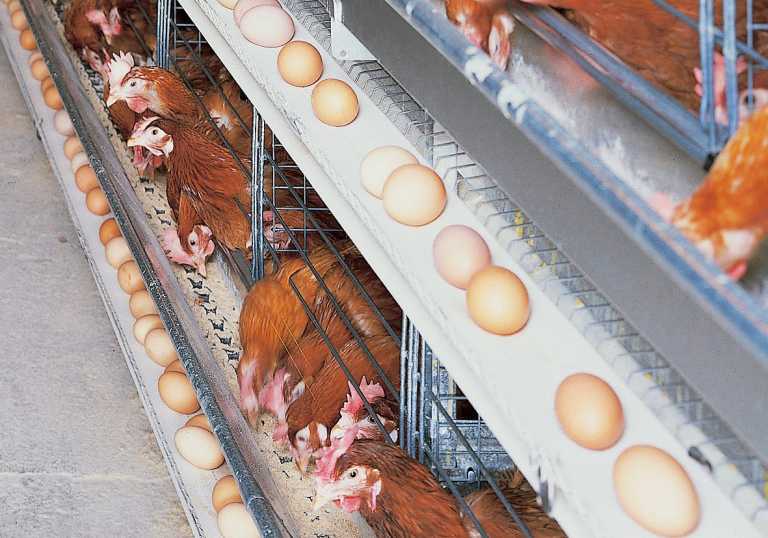
Improper nutrition
Hens need a balanced and adequate diet to maintain egg production. Each egg contains significant amounts of protein and energy, which must first be consumed by the hen as part of its daily food intake. Too little dietary energy or an imbalance of amino acids can cause depressed egg production. Many backyard flock owners don’t realize how much calcium a hen needs. The shell of each egg contains roughly 2 grams of calcium.
Since the skeleton of a typical modern egg-laying breed of hen only contains about 20 grams of calcium, each egg represents 10% of the hen’s total bodily calcium. While the hen’s skeleton acts as a calcium reserve to supply the demands of egg production, this reserve is rapidly depleted in the absence of an abundant calcium source in the feed eaten by the bird. In such a situation the hen will stop laying eggs. To maintain egg production, flock owners should feed only a prepared layer ration balanced to meet a hen’s nutritional requirements, or at least provide a particulate source of calcium, e.g. suitably sized ground limestone or oyster shell, that the birds can eat selectively according to their needs. The layer ration or calcium source should be available from a local feed supply store.
Occasionally, a feed mixing error causes important nutrients like salt to be left out of the diet. Insufficient dietary salt will depress egg production. Conversely, in some regions, well water may have too much dissolved sodium, which also will depress egg production. If water quality is suspected to be a problem, a water mineral analysis can be obtained through your county extension office, but be sure to contact the office for instructions before drawing the water sample.
Molt
After a hen has been producing eggs for several months, she becomes increasingly likely to molt. Molting and egg production are not mutually compatible, so when molting occurs, egg production ceases. The rest from egg laying allows the hen to restore its plumage condition by shedding old feathers and growing new ones. At the same time, the hen’s reproductive tract is rejuvenated, allowing it to increase its rate of egg production and produce higher quality eggs when it returns to lay. Under natural day lengths, molting tends to coincide with the change in season so that hens molt in the fall after they cease egg production due to declining day lengths. In these circumstances, it is normal for all the hens in a flock to go out of production and molt more or less in synchrony. However, if artificial lighting is provided, a hen may molt at any time of year and not in synchrony with other hens. If this happens, she should return to lay in several weeks.
Old Age
So your chicken has been laying over 200 eggs a year, and they have just stopped laying. Unfortunately as chickens get older the amount of eggs they lay slows down. Look at the image below and you can see you normally only get around 3 years of good egg laying from a chicken.

If your your chicken laid 200 eggs in their first year, they should lay around 168 eggs in their second year, 128 eggs in their third year. This number will continue to decrease down to around 40 eggs by their tenth year. If your chickens are getting slightly older then a decrease in their egg laying is perfectly natural and expected. There is nothing you can do about this and it is simply nature’s way as your chickens age.
Disease
Many poultry diseases will affect egg production. Often the birds will show symptoms of illness, but sometimes they will not. If a disease is suspected, it is important to consult a poultry veterinarian without delay. A timely diagnosis may allow effective treatment for some diseases. In the case of certain virulent diseases such as highly pathogenic Avian Influenza, a speedy diagnosis may prevent losses of whole flocks in entire regions, and minimize the risk of zoonotic transmission of deadly disease from chickens to humans, e.g., bird flu.
Broodiness
Some breeds of hens are prone to become broody, meaning that they will try to incubate eggs to make them hatch. When this happens, they stop laying eggs. They are more likely to become broody if they are allowed to accumulate eggs in a nest. The problem is most prevalent during spring under natural daylight as the hens come into production due to the stimulating effects of increasing day length. To avoid this problem, it is best to pick up eggs at least once a day to prevent the hen from building a clutch. Daily egg gathering is also an important practice to preserve the safety and quality of eggs for human consumption. If the housing facilities permit, hens can be moved to different living quarters periodically to disrupt their attachment to specific nesting sites.